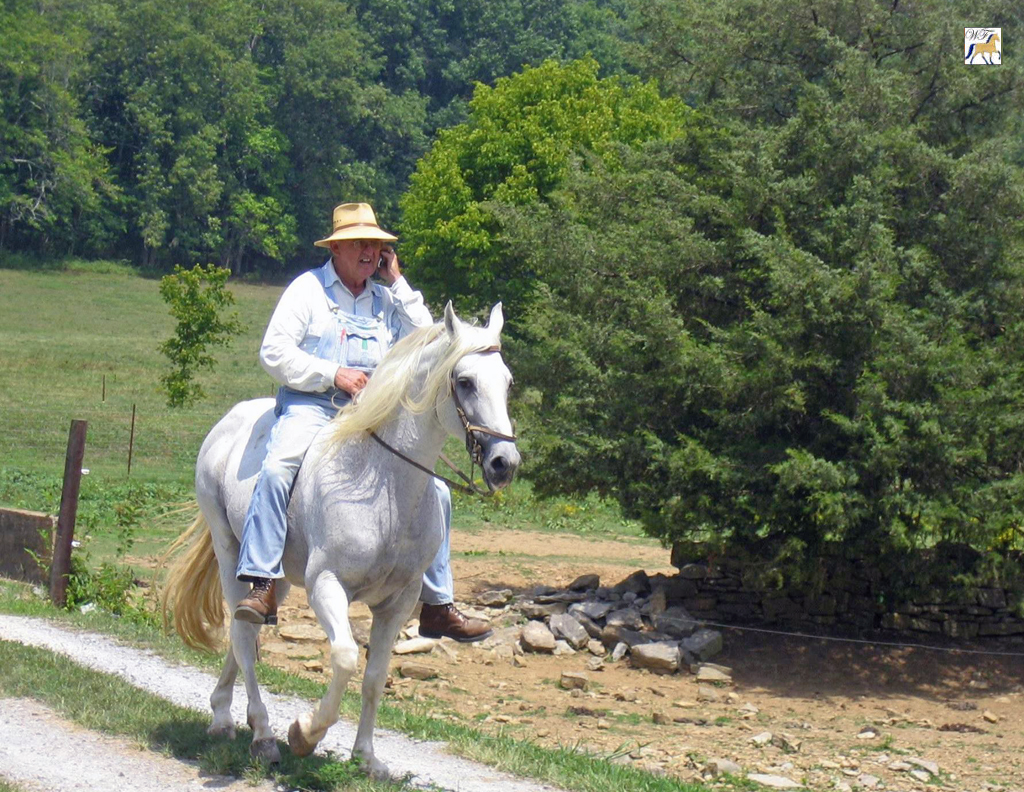|
BUDíS STERLING
BULLET; STILL IN THE OLIVER FAMILY
by Franne Brandon
The year was 1923.
America
had recovered from the Great War and had entered a
decade of affluence. Automobiles had become common,
womenís skirts were shorter, and a period of prosperity
ensued.
In 1923, a
Marshall County farmer named R.H. Clark purchased
a two year old sorrel stallion prospect. The colt was
sired by Major Allen, a son of the noted show mare
Merry Legs, both
bred by Albert
Dement of the Normandy community in Bedford County. The
dam of the sorrel colt was a daughter of Denmark Allen,
later know as Roan Allen,
making the colt a linebred Allan colt.
Clark
offered the young stallion at public stud. With few
telephones and no magazines to run advertisements, he
did as other stallion owners of the time. He had stud
posters printed and posted them at places where the mare
owners gathered. The young stallionís bloodlines spoke
for themselves. Mares began coming to Red Allenís court.
Twelve years passed. In April of
1935, a group of gentlemen met at Lewisburg, Tennessee,
near Clarkís home.
Their intentions were to organize a registry to record
the pedigrees of Tennesseeís native saddle horse that was so
different from the Saddlers north in
Kentucky. The gentlemen,
however, decided not to use the already familiar term
plantation horse, but to coin a term indicative of the
unique movement of the horses that they were breeding.
They named the infant registry the Tennessee Walking
Horse Breeders Association of America.
Two years later, in 1937, R.H.
Clark registered his sorrel stallion with the TWHBAA.
Several of the horseís offspring
already had been registered by this point.
Clarkís Red Allen
continued to be promoted by word of mouth and stud
posters
The stout red stallion outlived
his master. Upon Clarkís
death in 1939, Clarkís
daughter Sarah Clark Oliver inherited the old stallion.
Her husband, Herman Oliver, was a farmer, breeder, and
trader who supported his wife and sons through the
products of the family farm. His philosophy being that
everything was for sale, he insisted on showmanship at
all times, that nothing would be presented to the public
unless it was in the best of condition. Only one animal
escaped Oliverís sales list. Sarah Clark Oliverís
fatherís stallion died the property of Mrs. Herman
Oliver.
Although
Herman Oliver did not keep a son of
Clarkís Red Allen to
continue the legacy of those bloodlines within his
breeding program, other people did.
The majority of grand-get of old
Clarkís Red Allen,
though, can be attributed to a son who was bred and kept
all his life by one of R.H. Clarkís sons.
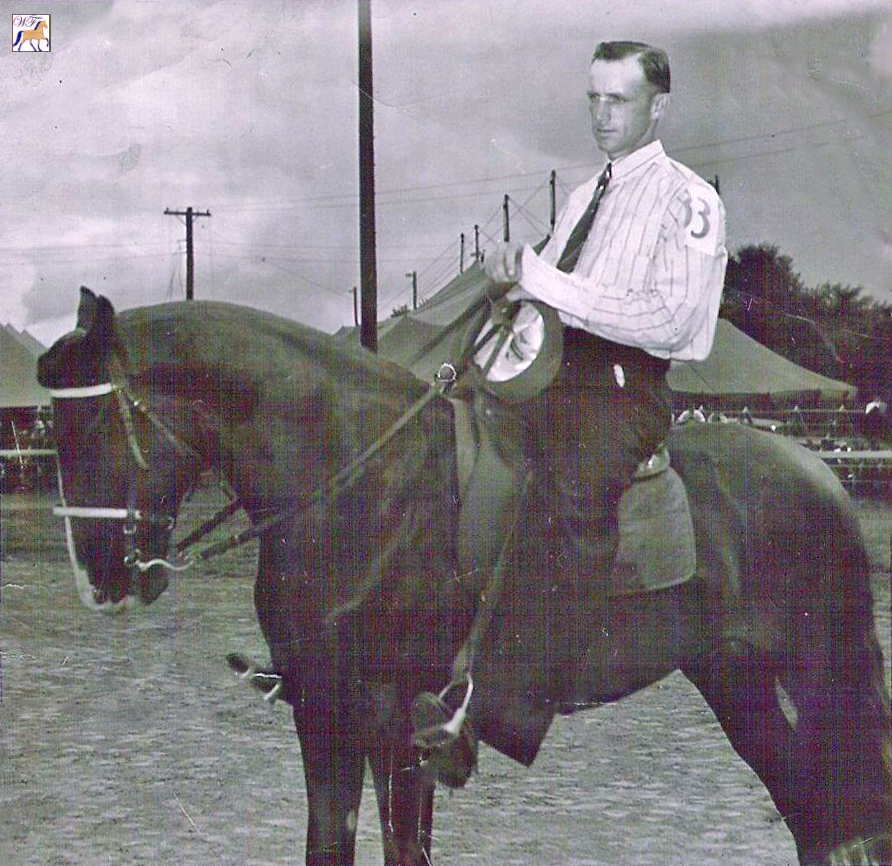 Jesse Clark raised a dark red
colt by his fatherís stallion out of a mare named Lizzie
Allen, a daughter of
Hunterís Allen F-10. Foaled in 1937, this colt was
registered as Red Bud Allen.
As a two year old, Red Bud
Allen was broke to ride, and even made a few shows
under the training of Zolly Derryberry.
Jesse had a special relationship with this very
intelligent stallion, not only
riding him and using him in the stud, but also
teaching him tricks. During his life,
Red Bud Allen sired 145
registered foals. The vast majority were bred in the
heyday of the young breed during the mid to late
forties, after the death of
Clarkís Red Allen.
During the final years of his life, he bred very
few mares, as the times had turned to the padded show
horse, black was the color in vogue, and the bloodlines
of the padded horses were those in demand. In the last
years, when the old stallion was in his late twenties,
he sired only five foals. Three of those five were out
of a bay mare named Merry Manís Star. Jesse Clark raised a dark red
colt by his fatherís stallion out of a mare named Lizzie
Allen, a daughter of
Hunterís Allen F-10. Foaled in 1937, this colt was
registered as Red Bud Allen.
As a two year old, Red Bud
Allen was broke to ride, and even made a few shows
under the training of Zolly Derryberry.
Jesse had a special relationship with this very
intelligent stallion, not only
riding him and using him in the stud, but also
teaching him tricks. During his life,
Red Bud Allen sired 145
registered foals. The vast majority were bred in the
heyday of the young breed during the mid to late
forties, after the death of
Clarkís Red Allen.
During the final years of his life, he bred very
few mares, as the times had turned to the padded show
horse, black was the color in vogue, and the bloodlines
of the padded horses were those in demand. In the last
years, when the old stallion was in his late twenties,
he sired only five foals. Three of those five were out
of a bay mare named Merry Manís Star.
Foaled in the fifties, Merry
Manís Star was not registered until 1965. In 1965,
however, the breeders association changed its
registration rules. All foals had to be registered
during the year that they came, and any adult horses
whose paperwork was not in order had to obtain
registration certificates then, or be reduced to grade
horse status. Leon Oliver, who had returned from Army
service, made the choice to produce a foal by his
uncleís horse out of Merry Manís Star. The bay mare went
to the Delina area of Marshall County
for a tryst with Red Bud
Allen for three consecutive years.
The first product of the mating
of Red Bud with Starr was a filly. The next two years,
in 1966 and 1967, Oliver was more successful in
obtaining the stud colts that he wanted, first in 1966,
then in 1967, another colt arrived posthumously. He
became Red Budís Rascal.
When Oliver lost the older colt, it remained to
Red Budís Rascal to
carry forward the equine heritage of his sire and his
grandsire.
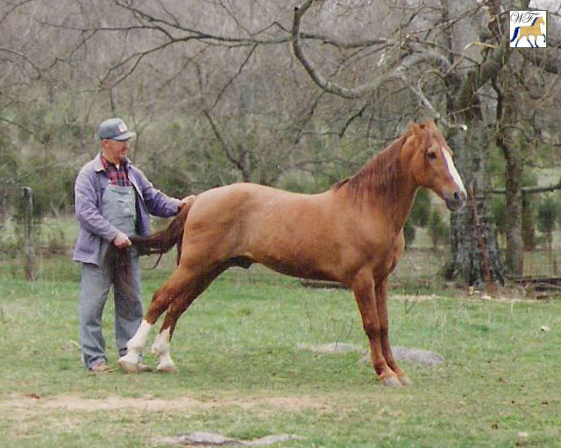 Red
Budís Rascal had been foaled the spring after the
victory of the four year old stallion
Shakerís Shocker in
the Grand Championship Stake at the Tennessee Walking
Horse National Celebration. An extremely popular winner
with his petite blond owner and trainer in the irons,
Shocker inspired a surge of popularity for the padded
show Tennessee Walking Horse. Interest in the kegshod
registered horses was at another all-time low.
Red Budís Rascal
arrived with the wrong gait genes, the wrong pedigree,
and the wrong color to attract any interest from the
vast majority of mare owners in the vicinity of his home
barn. Red
Budís Rascal had been foaled the spring after the
victory of the four year old stallion
Shakerís Shocker in
the Grand Championship Stake at the Tennessee Walking
Horse National Celebration. An extremely popular winner
with his petite blond owner and trainer in the irons,
Shocker inspired a surge of popularity for the padded
show Tennessee Walking Horse. Interest in the kegshod
registered horses was at another all-time low.
Red Budís Rascal
arrived with the wrong gait genes, the wrong pedigree,
and the wrong color to attract any interest from the
vast majority of mare owners in the vicinity of his home
barn.
Red
Budís Rascal began the pattern of the life of an
Oliver farm stallion. Strong boned, red, and naturally
walking, he seemed unsuited for the times.
The first dozen years of
Red Budís Rascal's life
passed.
Leon became the familyís collector and preservationist.
He tried to keep alive the bloodlines of every animal
that he had owned, even a heifer given him by his uncle!
In 1979, Leon felt that the ever-swinging pendulum in
the Tennessee Walking Horse business was beginning to
change its direction. Trail rides were becoming popular
once more, shows were beginning to add classes for
plantation horses, and interest in the pleasure aspect
of the breed was on the upswing. Anticipating better
days ahead, Oliver ordered a set of business cards
advertising the specialties of his farm, and advertising
Red Budís Rascal as an
ďold bloodlineĒ stallion, a grandson of Clarkís Red Allen, born
in 1921.
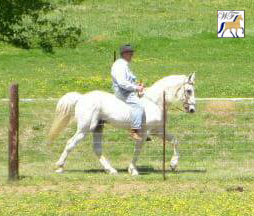 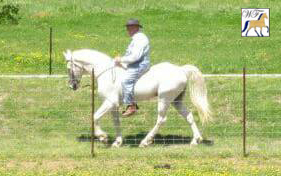 In 1984, the Pleasure Walking
Horse Association of Tennessee was formed to promote the
pleasure walker in the state of its origin. Leon joined the group and supported
its magazine, PWHAT News, with his business card
ad. Through this ad, many people whose interest was the
natural walking horse from the older bloodlines that had
not been bred to pace learned of
Red Budís Rascal. Mares
came to the stallionís court that had never visited
before. The resulting
Red
Budís Rascal foals had good gaits, strong bones, and
sweet dispositions to go along with good minds. Mares
owners came back again. When the foals went under
saddle, many owners were so pleased with their horses
that they were never on the market. Like two of the
early fillies by Bud, Lonesome Last One and Red Budís
Lady, they would remain forever with the same owners. In 1984, the Pleasure Walking
Horse Association of Tennessee was formed to promote the
pleasure walker in the state of its origin. Leon joined the group and supported
its magazine, PWHAT News, with his business card
ad. Through this ad, many people whose interest was the
natural walking horse from the older bloodlines that had
not been bred to pace learned of
Red Budís Rascal. Mares
came to the stallionís court that had never visited
before. The resulting
Red
Budís Rascal foals had good gaits, strong bones, and
sweet dispositions to go along with good minds. Mares
owners came back again. When the foals went under
saddle, many owners were so pleased with their horses
that they were never on the market. Like two of the
early fillies by Bud, Lonesome Last One and Red Budís
Lady, they would remain forever with the same owners.
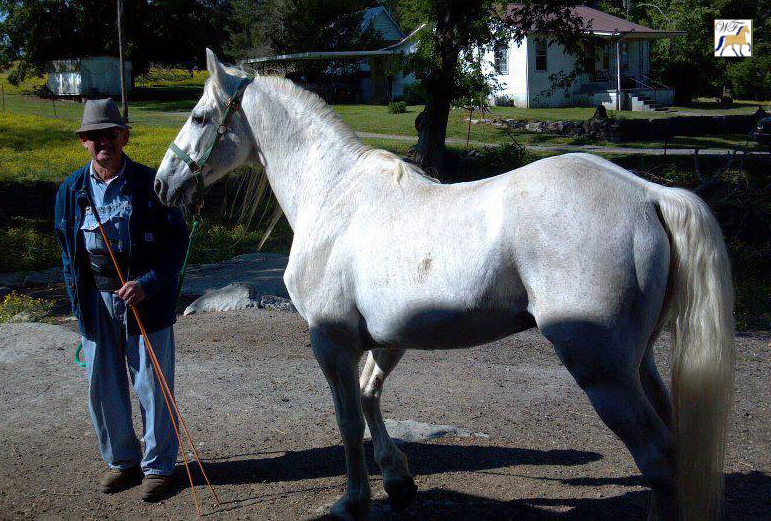 During the eighties, a parallel
trend to that of discovering old foundation bloodlines
without the padded show strains was an emphasis on
color. Perceiving a need for a stallion of color, Oliver
searched until he found a handsome grey tracing its
color line to Top Wilson. The second mating of the two
resulted in a dark chestnut colt also blessed with the
grey gene. Naming the colt Buds Sterling Bullet, Oliver
groomed him as a future stallion prospect for Brown Shop
Road Farms. During the eighties, a parallel
trend to that of discovering old foundation bloodlines
without the padded show strains was an emphasis on
color. Perceiving a need for a stallion of color, Oliver
searched until he found a handsome grey tracing its
color line to Top Wilson. The second mating of the two
resulted in a dark chestnut colt also blessed with the
grey gene. Naming the colt Buds Sterling Bullet, Oliver
groomed him as a future stallion prospect for Brown Shop
Road Farms.
Since Bullet, as the grey colt
was known, went through the same regimen as his
grandsire, he was ridden at two, trained to obey
commands at liberty, and only met his first small court
of mares at three. Of the six that he bred, five
produced grey foals the following spring. In later
years, Bullet attracted a large court of mares. A very
obedient and intelligent stallion, he could be ridden by
both his owner and anyone with reasonable riding
experience. Many ads for Bullet ended with ďCome ride
him, and then decide on the sire of your next foal.Ē
Visitors to the farm did just that, leaving
impressed that the horse behaves impeccably with a
strange rider aboard.
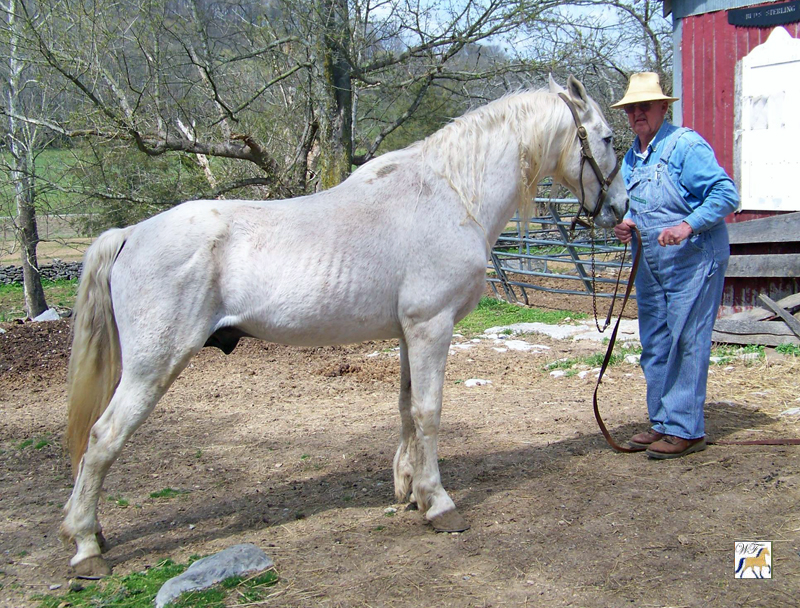 Bullet foals, along with those
by Red Budís Rascal,
have gone to all parts of the United States, to Canada,
and even to Europe. They continue to represent the type
of Tennessee Walking Horse that endeared the breed to
horsemen in the early developmental years of the
registry. Bullet foals, along with those
by Red Budís Rascal,
have gone to all parts of the United States, to Canada,
and even to Europe. They continue to represent the type
of Tennessee Walking Horse that endeared the breed to
horsemen in the early developmental years of the
registry.
Red
Budís Rascal died on
July 13, 1997, two months past his 30th
birthday. As promised, Oliver buried the faithful old
stallion in a shady spot in front of the barn where he
had spent all his life. A granite marker at the
gravesite bears the simple epitaph ďRed
Budís Rascal, 1967-1997, Pleasure Sire.Ē The
following year, eleven foals gamboled in the sunshine in
testament to a grand old stallion who gave his all until
the very last day.
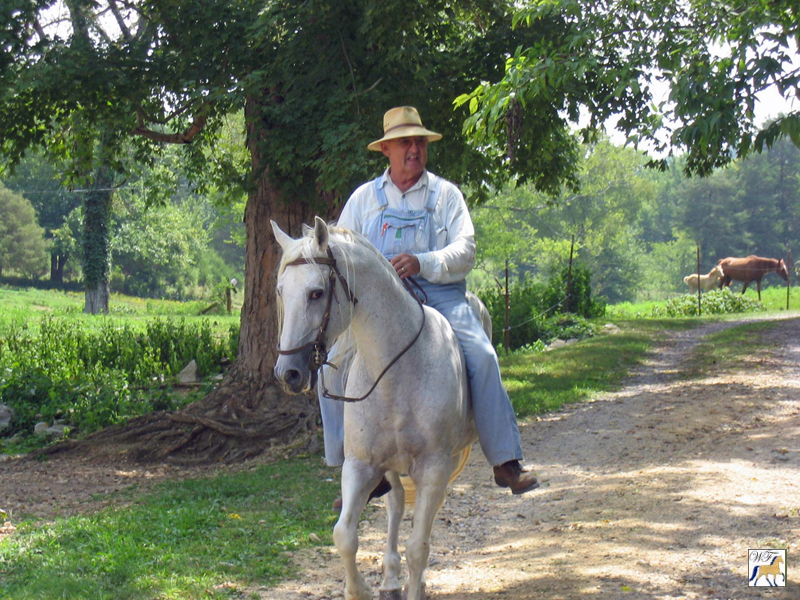 Since
the death of Red Budís
Rascal, Bullet has assumed senior stallion duties at
Brown Shop Road Farms, consistently attracting mares
whose owners value the traits that Bullet puts in his
foals. Editions of the Voice Sire Summary since
2006 listed Buds Sterling Bullet as one of the ďTop 100
SiresĒ. Trail geldings by Bullet, especially the grey
ones, continue to be in great demand, so much so that
the area is often sold out of them.
Mares by Bullet have now entered the broodmare
ranks, and these ladies are proving that they can
produce what both the trail and pleasure show worlds
demand. In the Midwest,
Sterlingís
Dolly, a Bullet daughter out of a mare by Steve Oliverís
Markís Crackerjack,was the dam of
the two year old champion at the 2005 Minnesota
Futurity. Her yearling filly took a blue in halter
against all breeds in her first trip to the show ring in Virginia. Since
the death of Red Budís
Rascal, Bullet has assumed senior stallion duties at
Brown Shop Road Farms, consistently attracting mares
whose owners value the traits that Bullet puts in his
foals. Editions of the Voice Sire Summary since
2006 listed Buds Sterling Bullet as one of the ďTop 100
SiresĒ. Trail geldings by Bullet, especially the grey
ones, continue to be in great demand, so much so that
the area is often sold out of them.
Mares by Bullet have now entered the broodmare
ranks, and these ladies are proving that they can
produce what both the trail and pleasure show worlds
demand. In the Midwest,
Sterlingís
Dolly, a Bullet daughter out of a mare by Steve Oliverís
Markís Crackerjack,was the dam of
the two year old champion at the 2005 Minnesota
Futurity. Her yearling filly took a blue in halter
against all breeds in her first trip to the show ring in Virginia.
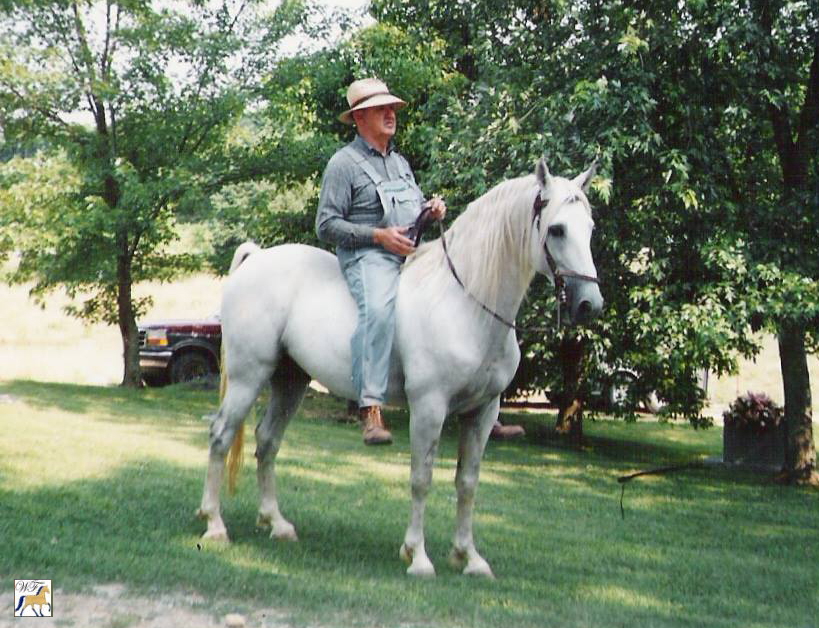 Since retiring from his job with
the state of Tennessee, Leon Oliver has devoted much of
his energy to the pursuit of his breeding goals. He has
owned mares of Red Budís
Rascal breeding that he crossed quite successfully
with Buds Sterling, and his current Junior Stallion is a
Bullet son out of the mare Markís Diamondone of the last
daughters of markís Crackerjack, At age 29, Buds
Sterling Bullet no longer serves as a riding horse, but
he remains alert and responsive to his owner and
welcoming to farm visitors. Truly an impressive horse
who has made an impact on the pleasure Tennessee Walking
Horse ranks. Since retiring from his job with
the state of Tennessee, Leon Oliver has devoted much of
his energy to the pursuit of his breeding goals. He has
owned mares of Red Budís
Rascal breeding that he crossed quite successfully
with Buds Sterling, and his current Junior Stallion is a
Bullet son out of the mare Markís Diamondone of the last
daughters of markís Crackerjack, At age 29, Buds
Sterling Bullet no longer serves as a riding horse, but
he remains alert and responsive to his owner and
welcoming to farm visitors. Truly an impressive horse
who has made an impact on the pleasure Tennessee Walking
Horse ranks.
|
